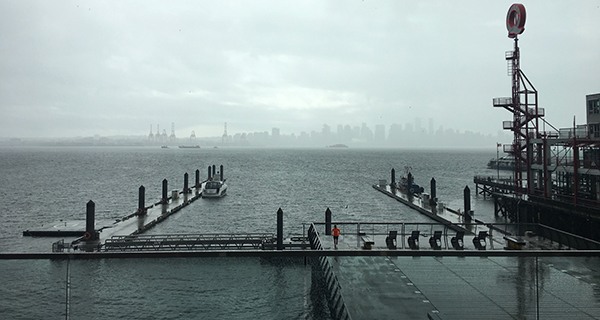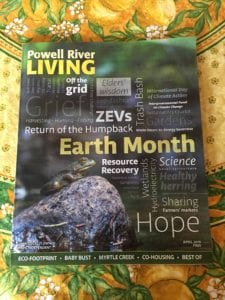 How are the National Post and the Globe and Mail doing in your neighbourhood?
How are the National Post and the Globe and Mail doing in your neighbourhood?
In Powell River, the big Toronto newspapers are on their last boomer gasp at the newsstands. In their place, piles of the weekly Powell River Peak and monthly Powell River Living fly off the counters and adjacent distribution boxes.
The local media cover sports, school events, city council, Qathet Regional District and Tla’amin Nation local government news, and provide a welcome forum for editorial comment and letters to the editor.
In the words of a rural Saskatchewan Facebook pal of mine, Patricia Robertson, “This is the exciting new direction of publishing: localized, personalized and relevant. It’s a solution to all of that canned content that is so watered down it appeals to no one.”
Patricia wrote those words in response to my posting of a picture of Powell River Livings’ April cover. It celebrates Earth Month and is covered with subheadings like: Elders’ wisdom, Waste Steam-to-Energy Generator, Sharing Farmers’ markets, Sustainability Charter, Intergovernmental Panel on Climate Change, Trash Bash, Return of the Humpback, and Hope.
When I first saw this issue, printed in varied shades of green and paid for by local advertising, I immediately picked up a copy and started to read.
Really, who cares what Conrad Black has to say this week?
Since posting that cover picture and reaping lots of local ‘likes,’ I’ve been thinking of other examples of radical localism in place of globalized urban chic. Many associate the latter with gross expense, imported notions of what’s important, and growing irrelevance.
The world of arts and culture offers lots of examples.
Consider the Vancouver Art Gallery’s endless championing of its new building and its associated fundraising campaign. The old VAG, nestled in the 1906 neo-classical Rattenbury Courthouse (arguably the first important B.C. architect), has suffered the ongoing indignity of not being deemed globally chic enough over the last decade.
A $350-million replacement (inclusive of a $50-million endowment) has consequently been designed by a Swiss architectural firm. But the fundraising goal is elusive – $165 million is still being sought from private sources, federal and provincial governments.
Meanwhile in North Vancouver and at the resort village of Whistler, two magnificent community art galleries have been built with the notable philanthropic assistance of B.C. developer Michael Audain.
The $43.5-million Audain Art Museum in Whistler houses the Audain personal collection.
The Polygon Gallery in North Vancouver cost $18 million with a $4-million contribution from the Audain Foundation and Polygon Homes. It features magnificent photographic art.
The Audain Foundation has also been a significant contributor to the exquisite Bill Reid Gallery of Northwest Coast Art, just down the street from the VAG.
These three smaller galleries celebrate brilliant local architecture (the Audain and Polygon galleries are designed by Vancouver’s award-winning Patkau Architects), and champion local artists – the very essence of creative indigeneity and, arguably, their relevance.
That localized, personalized and relevant spirit is also infecting the music scene outside the urban core of Vancouver. A burgeoning collection of choral, jazz, opera and symphony festivals are growing now on Vancouver Island and the adjacent Sunshine Coast.
Just last week, the Pacific Region International Summer Music Academy (PRISMA), based in Powell River, promoted its June 17 to 29 festival at the Bill Reid Gallery and at the University of British Columbia. Both events featured PRISMA’s conductor and cellist Arthur Arnold, and internationally-renowned pianist Edwin Kim of Baltimore. Arnold is also the maestro of the Moscow Symphony Orchestra when he’s not at his summer home in Powell River.
PRISMA, now in its seventh season, competitively selects about 90 international music students (from 17 countries in 2018) to train in performing classical symphonic repertoire in front of thousands of local residents and tourists. For all of these highly-motivated students, PRISMA is an exquisite cultural opportunity that helps qualify them for global symphony spots when they graduate.
Considering all of these localized and personalized print media, visual arts, architectural and performance examples, is watered-down, canned urban content relevant?
Troy Media columnist Mike Robinson has been CEO of three Canadian NGOs: the Arctic Institute of North America, the Glenbow Museum and the Bill Reid Gallery.
The views, opinions and positions expressed by columnists and contributors are the author’s alone. They do not inherently or expressly reflect the views, opinions and/or positions of our publication.




Ah, nice to see parochialism is still alive and well in Powell River and BC.
Dana Wilson
Ah, nice to see parochialism is still alive and well in Powell River and BC.
Dana Wilson